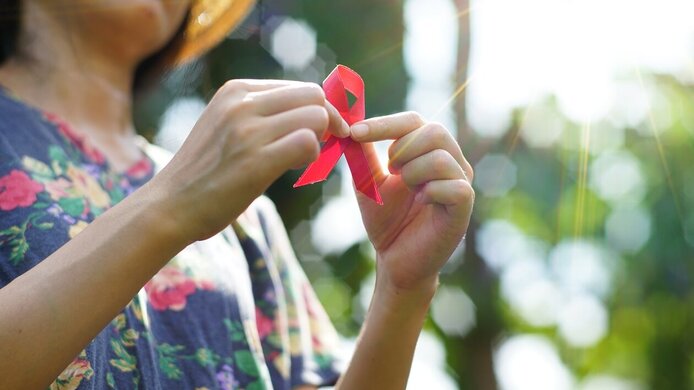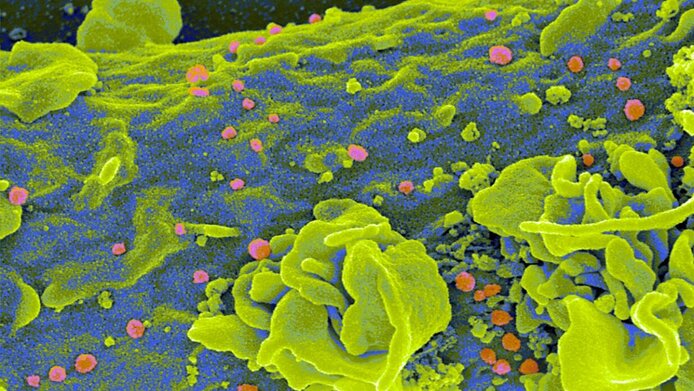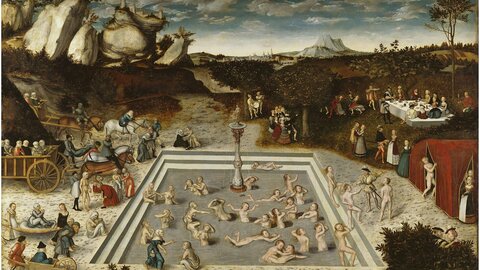HIV infection: the brevity of the right moment

“HIV has been intensively investigated in research labs all over the world for more than 30 years”, says Doris Wilflingseder, and throughout that time it has been resisting effective treatment. “The virus mutates incredibly fast and plays a cat-and-mouse game with our immune system”, adds Wilflingseder, a researcher at the Medical University of Innsbruck in the interview with scilog. Within the context of the FWF-funded project HIV infection and transmission close to reality, the immunologist heads a research group which works on describing the interaction of the virus with the immune system – before the immune deficiency spreads and the body might still defend itself against the virus.
Initial contact as pivotal point
It is known that HIV infiltrates the genetic material of T helper cells, which constitute an essential element of the body’s immune response – and that makes the virus so dangerous. Instead of effectively fighting the intruder, these cells are exploited by the virus and thus support the virus attack until the immune system finally breaks down. “Our approach considers the initial contact between immune cells in the mucosa and the pathogens to be the pivotal point”, explains the scientist. She places her bet on the complement system, the part of the innate immune system which can immediately destroy pathogens. “This part of our immune defence system is not taken into account by most other research teams, although it is a key element in the acute infection phase and can contribute to a successful fight against the virus”, explains Wilflingseder. Basically, the complement system coats the invading HI-virus, thus marking it as such for the immune cells. Dendritic cells are then able to perceive the virus as an intruder and spring into action. These sentinels of the skin and mucosa apprehend anything they perceive as a foreign substance and deliver their prey “free of charge” to T helper and killer T cells.
Devil in the detail
“Our trials and investigations have illustrated that complement-coated HIV is detected more readily by dendritic cells and, subsequently, more efficiently battled by effector cells than a virus that carries no immunological marker.” On basis of these results achieved by Wilflingseder on cell cultures, a therapeutic vaccine might, in principle, be conceivable – in principle only, because the devil is in the detail. In this case it is the fact that the window of opportunity is only open for two weeks. “After that time, we see the emergence of HIV-specific antibodies that recognise the virus but do not neutralise it in that time span. In this way, the immune response conveyed by the dendritic cells is changed again, since other receptors get stimulated on the cells”, notes Wilflingseder. “Right now, our research aims at gaining a better understanding of the immune system and these coating processes specifically at the beginning of the infection. We hope this will help us to find ways of strengthening the immune system even during the chronic phase of HIV infection”, says Wilflingseder, putting any premature hopes for treatment into perspective.
The potential of new models
The researcher does see definite success and progress in another field. Doris Wilflingseder started and refined her investigations with the help of cell cultures. “Cell cultures are often very simple. They have none of the more complex structures we find in different types of tissue”, she summarises. For a long time scientists skirted this disadvantage by using animal testing. “But now we are establishing really good 3D cell culture models. Lab-grown 3D structures and organoids increase our chances even further.” The researcher is convinced that animal testing is not only dubious but also substitutable in many cases. “I collaborate closely with physiologists and bio-informatics experts on developing 3D cultures.” Wilflingseder contributes her expertise and instinctive understanding of 3D cultures to this process. “Knowing intuitively when to change the media and when to take samples is important.” Quite frequently, confirms the scholar, the right time does not follow a regular pattern. In order to suss it out one needs experience and creativity. “It’s comparable to cooking. It is striking that people who can cook and bake also have a good instinct for cell cultures.” The new models provide a better way, and, even more importantly, a method involving the human immune system, of investigating cancer and infections in a more relevant system.
Personal details
Doris Wilflingseder has a PhD in biology. After various positions, including as a visiting scientist at University College London, she now holds the position of an Associate Professor working in immunological basic research at Medical University of Innsbruck. Since 2012, Doris Wilflingseder has been the Deputy Head of the Division of Hygiene and Medical Microbiology.
Publications
Chandorkar P, Posch W, Zaderer V, Blatzer M, Steger M, Ammann CG, Binder U, Hermann M, Hörtnagl P, Lass-Flörl C, Wilflingseder D: Fast-track development of an in vitro 3D lung/immune cell model to study Aspergillus infections, in: Scientific Reports 2017, http://doi.org/gbx4sx
Posch W, Steger M, Knackmuss U, Blatzer M, Baldauf HM, Doppler W, White TE, Hörtnagl P, Diaz-Griffero F, Lass-Flörl C, Hackl H, Moris A, Keppler OT, Wilflingseder D: (2015). Complement-Opsonized HIV-1 Overcomes Restriction in Dendritic Cells, in: PLoS Pathogens 2015, http://doi.org/f3sv6z
Wilflingseder D, Schroll A, Hackl H, Gallasch R, Frampton D, Lass-Flörl C, Pancino G, Saez-Cirion A, Lambotte O, Weiss L, Kellam P, Trajanoski Z, Geijtenbeek T, Weiss G, Posch W: Immediate T-Helper 17 Polarization Upon Triggering CD11b/c on HIV-Exposed Dendritic Cells, in: Journal of Infectious Diseases 2015, http://doi.org/f3ss89






